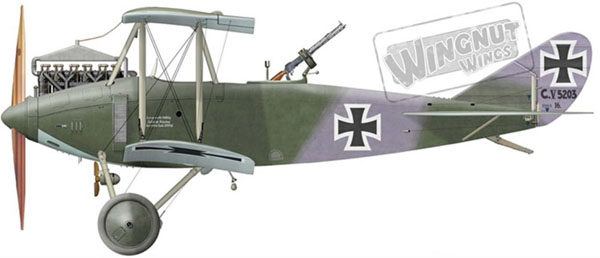
Feature Article by Dave Coward
Our thanks to Wingnut Wings for supplying our kit – get this and all the other great models in their range direct from their Wingnut Wings website
Background
The DFW C.V was arguably the single most important German aircraft of the First World War. The entire reason for military aviation at the time was to support the war on the ground and the most significant way to do this was through reconnaissance and artillery observation. A skilled artillery observer in a wireless equipped two-seater could kill more enemy with his index finger in a few minutes than the most skilled fighter pilots could in a lifetime and the DFW C.V was the most prevalent front line German two-seater of the war. Much mystery surrounds the development of the DFW C.V but the prototype appears to have first flown in May 1916 and passed its required structural tests in early August 1916 resulting in an order for 60 aircraft. By late October the 1st dozen or so production DFW C.V were serving at the front and had made such an impression that over the next couple of months 1000 more aircraft were ordered. Production continued up until the armistice, by which time nearly 4000 DFW C.V had been ordered from Deutsche Flugzeug-Werke (DFW) (2005), Automobile und Aviatik (1400), Luftverkehrsgesellschaft (LVG) (400) and Halberstädter Flugzeugwerke (150). LVG would go on to incorporate many aspects of the DFW C.V into their successful LVG C.V.

Early production DFW C.V featured a squared off nose, ‘ear’ radiators fixed to the sides of its plywood fuselage and aluminium cowlings fully enclosing the engine. The fuselage sides and bottom were covered in sheet ply with the smoothly curved upper surfaces created from strip ply ‘mouldings’, all covered with doped on fabric. The top and bottom wings were of conventional wood and wire construction while the ailerons and tailplane were assembled from welded steel tubes.
Mid production DFW C.V incorporated an internal PuW bomb rack, a more aerodynamic nose and a spinner for the propeller. Late production DFW C.V ordered from November 1916 onwards featured a single radiator installed on the cabane struts in front of the top wing instead of the ‘ear’ radiators. The incredibly versatile DFW C.V was used for reconnaissance, artillery observation, bombing, as a two-seat fighter/ground attack aircraft and, fitted with the NAG C.III engine, as a purpose built trainer. Because it was built by 4 different manufacturers and for a comparatively long time there are numerous small variations between airframes which we have done our best to recreate. Any history of this important aircraft here is of necessity very brief, therefore we encourage you to seek out the references mentioned below for a more thorough understanding of this important aircraft.
Aftermarket Extras:
• HGW Seatbelts
• EZ Line
• Lycra Thread
• Gaspatch Turnbuckles
The Build
When I was given this model to build and review I must admit I didn’t have it sitting up there in my list of things I must do ASAP as it was a bit plain and didn’t really grab my imagination that much. For this reason it sat in my pile of things to do for quite a while and then I was looking for a kit to use as a demonstration build for SMN`s Modelling in a Day Workshop in June 2015. What I needed was a simple(ish) WWI build that could be used to demonstrate a multiple number of techniques that were regularly employed in the construction of biplanes and on looking at what I had this kit nicely fitted the bill.
I wanted to pre-build up the kit into subassemblies that could be used to show certain finishing techniques and as a platform to demonstrate how to do others. With this in mind I set off on a whirlwind of building as the time frames were quite tight so what the pictures show are the finished sub-assemblies in many cases rather that a step by step account of the build process. As you will see, almost all the other WW builds in Finished Now have most, if not all of the whole build process and they very much follow a pattern.